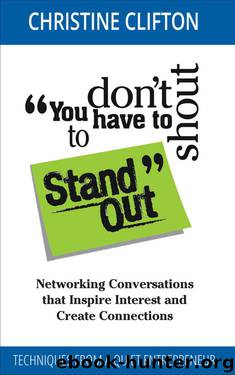You don't have to shout to Stand Out: Networking Conversations that Inspire Interest and Create Connections (Techniques from a quiet entrepreneur) by Christine Clifton

Author:Christine Clifton [Clifton, Christine]
Language: eng
Format: epub
Publisher: Mindful Business Press
Published: 2017-02-16T22:00:00+00:00
“As long as we’re waiting for them to be anything better, we will be constantly disappointed.”
– Marianne Williamson
When it comes to styles, people tend to fall into one group that has a primary concern about relationships and people interactions (Interactors and Supporters) or another group that has a primary concern about getting things done and task accomplishments (Directors and Contemplators).
In the same vein, people tend to fall into a group that has an energetic, demonstrative delivery style with a quick pace (Directors and Interactors) or a group that has a measured delivery style with a moderate pace (Contemplators and Supporters).
Without having to be a mind reader or a fortune teller, you can position your delivery energy in the manner that mirrors theirs and position your content on talking about the things that seem to matter the most to them. By taking this time to talk to them in the way that they talk, you are able to help them hear you better—because you’re speaking to them in their natural style.
Please don’t misunderstand me: I’m not asking you to change who you are. What I’m inviting you to do is to temporarily adjust how and what you deliver so that it lands more powerfully with your listener. You’re being a temporary chameleon, able to adjust as you go, and be heard by more people than just those who are your style.
Directors are demonstrative, quick-paced, and task-focused.
Interactors are demonstrative, quick-paced, and relationship-focused.
Supporters are measured, moderately-paced, and relationship-focused.
Contemplators are measured, moderately-paced, and task-focused.
Now, you may be reading this and thinking “hmm, this all sounds familiar. Is it….” NLP? (neurolinguistic programming) No. “Is it….” personality types? (Myers-Briggs/MBTI) No.
It’s called DISC and is based on decades of behavioral science research and is a very usable, everyday tool because you can make these observations about other people. You can see behaviors. You can hear what matters to them.
MBTI is more of an indicator of how someone is internally wired and DISC is an assessment of how people behave. With MBTI there are four letters for each of the sixteen types and with DISC there are four simple primary styles. To understand NLP, you need an in-depth workshop at minimum to begin to understand how to assess people and with DISC it only takes those two simple steps I just taught you—and a little bit of practice.
For those of you who know DISC and are thinking “wait a minute, those names are different from what I learned,” I’ve created the avatars of Director, Interactor, Supporter, and Contemplator because I feel these names paint a clearer picture of the different styles than the original DISC names.
When people feel understood and heard, they feel a greater connection to you. Our biology is affected with more oxytocin, which is that feel-good, connection hormone I mentioned earlier. Those being spoken to in this mindful way feel good and those witnessing the interaction also experience a rise in oxytocin so they feel good too. We’re a naturally collaborative species and this level of engagement can strengthen our feeling of community.
Download
This site does not store any files on its server. We only index and link to content provided by other sites. Please contact the content providers to delete copyright contents if any and email us, we'll remove relevant links or contents immediately.
Nudge - Improving Decisions about Health, Wealth, and Happiness by Thaler Sunstein(7242)
Deep Work by Cal Newport(6563)
Principles: Life and Work by Ray Dalio(5961)
The Doodle Revolution by Sunni Brown(4501)
Factfulness: Ten Reasons We're Wrong About the World – and Why Things Are Better Than You Think by Hans Rosling(4487)
Eat That Frog! by Brian Tracy(4149)
Thinking in Bets by Annie Duke(3996)
Hyperfocus by Chris Bailey(3902)
Visual Intelligence by Amy E. Herman(3620)
Writing Your Dissertation in Fifteen Minutes a Day by Joan Bolker(3573)
How to Win Friends and Influence People in the Digital Age by Dale Carnegie & Associates(3365)
Ogilvy on Advertising by David Ogilvy(3327)
Hidden Persuasion: 33 psychological influence techniques in advertising by Marc Andrews & Matthijs van Leeuwen & Rick van Baaren(3292)
How to win friends and influence people by Dale Carnegie(3268)
The Pixar Touch by David A. Price(3208)
Schaum's Quick Guide to Writing Great Short Stories by Margaret Lucke(3187)
Deep Work: Rules for Focused Success in a Distracted World by Cal Newport(2980)
Work Clean by Dan Charnas(2891)
The Slow Fix: Solve Problems, Work Smarter, and Live Better In a World Addicted to Speed by Carl Honore(2837)
